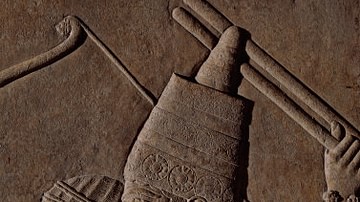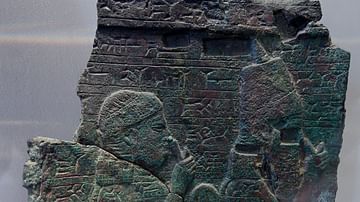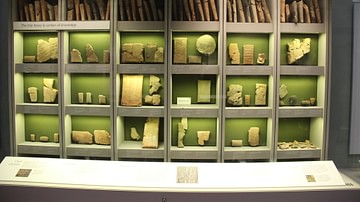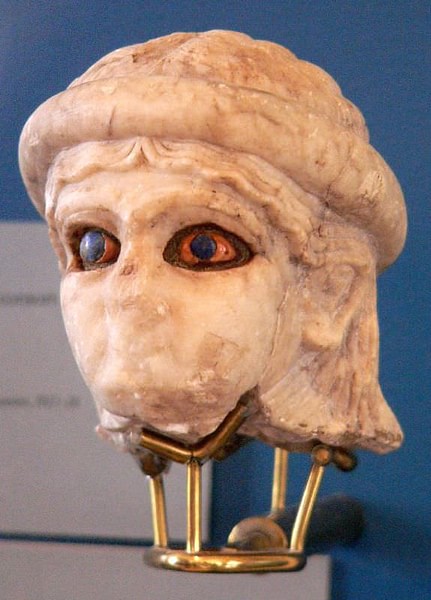
Nineveh (modern-day Mosul, Iraq) was one of the oldest and greatest cities in antiquity. It was originally known as Ninua, a trade center, and would become one of the largest and most affluent cities in antiquity. It was regarded highly by ancient writers other than those who created the biblical narratives which cast it in a negative light.
The area was settled as early as 6000 BCE and, by 3000 BCE, had become an important religious centre for worship of the goddess Ishtar. The meaning of the name is disputed but most likely relates to the prefix Nin or Nina which often appears in the names of deities (Ninhursag, Ninurta, among many others) and could have meant "House of the Goddess" or, specifically, "House of Ishtar" as the city was associated with that goddess from an early date.
It came directly under Assyrian rule during the reign of Shamashi Adad I (r. 1813-1791 BCE) but was most fully developed during the Neo-Assyrian Empire (912-612 BCE) by Sennacherib (r. 705-681 BCE), among the most famous Assyrian kings, and closely associated with the city as he made it the capital of the Neo-Assyrian Empire. Modern scholars also believe that he may have built the Hanging Gardens at Nineveh that were later credited to Babylon.
Nineveh is mentioned in the Bible, most notably in the Book of Jonah, where it is associated with sin and vice. Prior to its fall, however, Nineveh was the largest urban center in the world, ornamented by gardens, statuary, parks, and a zoo and was regarded as a great cultural center. The city was destroyed in 612 BCE by a coalition led by Babylonians and Medes which toppled the Assyrian Empire.
Early Development
Although the region was inhabited since the Neolithic Period and civilization established by c. 6000 BCE, the first people known to live there were the Hatti. These people, who built their great capital at Hattusa, most likely constructed the first city of Nineveh (though what it was called then is unknown). This early city (and subsequent buildings) were constructed on a fault line and, consequently, suffered damage from a number of earthquakes. Archaeological excavations have uncovered a number of cities which rose and fell on the site.
The Akkadians took the region during the reign of their first king Sargon the Great (2334-2279 BCE) who conquered all of Mesopotamia as well as Anatolian regions such as Cilicia. An earthquake in 2260 BCE destroyed the first temple of Ishtar at Nineveh, possibly constructed by Sargon the Great, which was rebuilt by the Akkadian king Manishtusu (r. 2270-2255 BCE) who also added on to the city. The Akkadians also assoiciated the city with Ishtar and held it, and the region at large, until the fall of their empire in c. 2083 BCE. At this time the Hatti regained their autonomy in the region briefly until they were overrun by the Assyrians and Amorites.
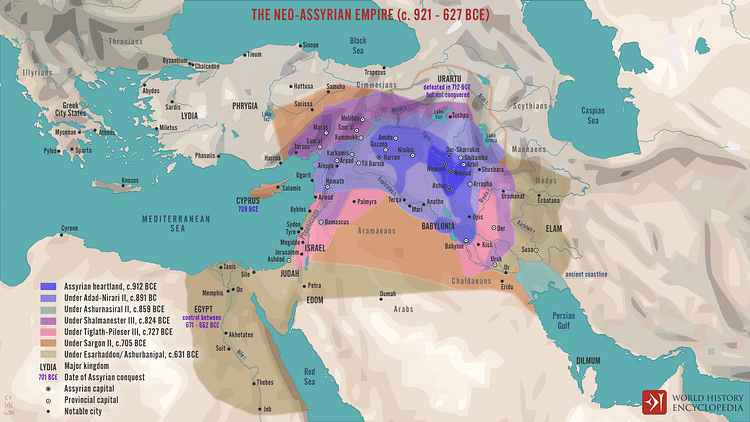
The Amorites occupied Nineveh and added to the temple, leaving behind inscriptions recording other construction projects which were later demolished. The Assyrian king Shamashi Adad I drove the Amorites from the region and established the Assyrian capital at Ashur while Nineveh flourished as a trade center. When Shamashi Adad I died, the region was conquered by the Amorites under King Hammurabi of Babylon (r. 1792-1750 BCE).
After Hammurabi's death, his kingdom fell apart and Nineveh was taken by the Assyrians under Adasi (r. c. 1726-1691 BCE). The territory was not fully secured by the Assyrians, however, until the reign of the great king Adad Nirari I (r. c. 1307-1275 BCE) who expanded Assyrian rule and established the boundaries of the Middle Assyrian Empire. King Shalmaneser I (r. 1274-1245 BCE, builder of the city of Kalhu) built a palace and temple at Nineveh, refurbished the city, and is thought to be responsible also for the first walls surrounding the settlement.
Nineveh was caught up in the power struggle between the Assyrians and the Hittites, Mitanni, and Hatti until the Bronze Age Collapse of c. 1200 BCE during which the entire region suffered in one form or another. The Assyrians emerged from the period intact, however, and their empire grew under the reign of Tiglath Pileser I (r. c. 1115-1076 BCE).
The Neo-Assyrian Empire
The Neo-Assyrian Empire, the last phase of Assyrian rule in the region, is the most famous of Assyrian kingdoms and Nineveh reached its height under the reign of its kings. The city grew dramatically in size, grandeur and fame under the reign of King Sennacherib who made Nineveh his capital. Sennacherib was the son of King Sargon II (r. 722-705 BCE) who had built his own capital, Dur-Sharrukin ("Fortress of Sargon") between 717-706 BCE. Sargon II and his son had never gotten along and so, when Sargon II died in 705 BCE, his successor wished to distance himself as much as possible from his father.
Sennacherib abandoned Sargon II's newly finished Dur-Sharrukin and moved the capital to Nineveh early in his reign. Anything which could be moved from Dur-Sharrukin was relocated to Nineveh. He built great walls around the city with fifteen gates, created public parks and gardens, aqueducts, irrigation ditches, canals, a zoo, and greatly expanded upon and improved the structures of the city. His palace had eighty rooms and he proclaimed it "the palace without rival" - the same phrase used by his father to describe his own palace at Dur-Sharrukin.
The historian Gwendolyn Leick notes, "Nineveh, with its heterogeneous population of people from throughout the Assyrian Empire, was one of the most beautiful cities in the Near East, with its gardens, temples, and splendid palaces" (132) and further cites Nineveh as having a carefully planned and executed series of canals and aquaducts to ensure a steady supply of water not only for human consumption but also to keep the public parks and gardens irrigated; an aspect of urban life not every city attended to with as much care and planning.
His "palace without rival" was aptly named as it was the grandest structure standing in Mesopotamia at the time. Scholar Stephen Bertman describes it:
The building's main axis was one-third of a mile in length. It featured a portico consisting of solid bronze columns resting on the backs of solid bronze lions and bulls, each of which weighed 43 tons. Inside, the palace was adorned with carved reliefs showing the king in the process of erecting colossal monuments or waging war against Assyria's enemies. (27)
Recent scholarship claims that the famous Hanging Gardens of Babylon were actually located at Nineveh and were constructed under Sennacherib's reign. The historian Christopher Scarre writes:
Sennacherib's palace had all the usual accoutrements of a major Assyrian residence: colossal guardian figures and impressively carved stone reliefs (over 2,000 sculptured slabs in 71 rooms). Its gardens, too, were exceptional. Recent research by British Assyriologist Stephanie Dalley has suggested that these were the famous Hanging Gardens, one of the Seven Wonders of the Ancient World. Later writers placed the Hanging Gardens at Babylon, but extensive research has failed to find any trace of them. Sennacherib's proud account of the palace gardens he created at Nineveh fits that of the Hanging Gardens in several significant details. (231)
After Sennacherib, his son Esarhaddon (r. 681-669 BCE) took the throne and continued his father's building projects. When Esarhaddon died on campaign in Egypt his mother Zakutu (l. c. 728-c. 668 BCE) legitimized the succession of his son Ashurbanipal as the new king. Under Ashurbanipal's reign (668-627 BCE) a new palace was constructed and he began the process of collecting and cataloging all of the written works in Mesopotamia.
The result of his efforts was the famous library of Ashurbanipal which held over 30,000 inscribed clay tablets, the books of that time. Other improvements and renovations were made to the city under Ashurbanipal's reign which further enhanced Nineveh's reputation as a city of extraordinary beauty and high culture. Palaces decorated with enormous and intricate relief paintings were constructed and the public gardens expanded upon and enhanced. Ashurbanipal's love of learning, and interest in written works (especially divination texts), drew scholars and scribes to the city in great numbers and the stability of his reign allowed for the development of the arts, sciences, and architectural innovations.
Ashurbanipal died in 627 BCE and his sons fought for control of the throne. The Assyrian Empire was so large by this time that maintaining it was almost impossible. The regions which were subject to Assyrian rule had been trying to break free for years and, finally, they saw their chance. The historian Simon Anglim writes:
Though the Assyrians and their army were respected and feared, they were most of all hated...by the last quarter of the seventh century BCE nearly every part of the empire was in a state of rebellion; these were not just struggles of freedom but wars of revenge. (186)
Military incursions by the Persians, Babylonians, Medes, and Scythians began in earnest in 625 BCE and the already weakened Neo-Assyrian Empire could not hold off a full-scale invasion for very long. In 612 BCE the city of Nineveh was sacked and burned by the allied forces of the Persians, Medes, Babylonians, and others who then divided the region between them. The area was sparsely populated thereafter and, slowly, the ancient ruins became buried in earth.
Biblical Nineveh
In 627 CE the area was the site of the Battle of Nineveh, the decisive Byzantine victory in the Byzantine-Sassanid War (602-628 CE). This engagement brought the region under Byzantine control until the Muslim conquest of 637 CE. While other great cities of ancient Mesopotamia were recognizable from their ruins, of Nineveh there was not a trace.
The city was best known through the Christian era (and still is) by the central role it plays in the biblical Book of Jonah. The Book of Jonah was written between 500-400 BCE depicting events from hundreds of years earlier in the reign of the Hebrew King Jeroboam II (786-746 BCE). While, in The Book of Jonah, the city is spared the wrath of God, other references to Nineveh in the Bible (The Books of Nahum and Zephania, among them) predict the destruction of the city by God's will. It is certain, however, that these works were written after the city had already fallen and the `prediction' is, therefore, simply re-worked history.
The biblical Book of Tobit takes place in Nineveh and the Gospels of Matthew (12:41) and Luke (11:32) both make mention of the city. As with Babylon, Nineveh is never mentioned favorably in the biblical narratives and, as the focus of those writers was on the story of the god of the Hebrews, no mention is ever made of the cultural and intellectual heights to which Nineveh rose in its prime. In fact, in the Book of Nahum 3:7, the writer states that Nineveh has fallen and asks, rhetorically, who will mourn for her:
And it shall come to pass, that all they that look upon thee shall flee from thee, and say, Nineveh is laid waste: who will bemoan her? Whence shall I seek comforters for thee?
Although the writers of the biblical narratives may have thought poorly of the city, it was among the greatest intellectual and cultural centers of its time and there were no doubt many who mourned the city's destruction.
Conclusion
The ruins of Nineveh lay buried until they were uncovered and excavated by Austin Henry Layard in 1846 and 1847. Further work by Campbell Thompson and George Smith, among others up to the present day, has revealed the magnificent scope of this once great city. The site is known today by the two mounds which cover it: the Kuyunjik and the Nebi Yunus.
The Kuyunjik mound has been excavated and all major finds come from this area. The Nebi Yunus mound (Mound of Prophet Jonah) remains untouched owing to an Islamic shrine to the prophet and a cemetery built there. In the 1990's the site was vandalized and a number of well preserved panels broken and stolen which later appeared for sale on the antiquities market.
Today the ruins of Nineveh are in danger of encroaching urban sprawl from the suburbs of Mosul and have been damaged by further acts of vandalism. In 2010, Global Heritage Fund listed the ruins among its Top Twelve endangered sites for these reasons among others. Once, however, the city was among the greatest of Mesopotamia, home to the goddess Ishtar, and there is no doubt that Sennacherib, and the kings who built before and after him, believed that the glory of Nineveh would last forever.



